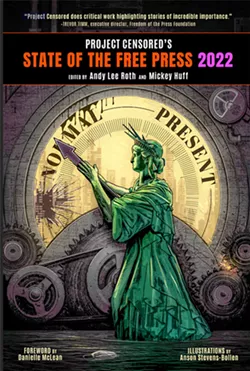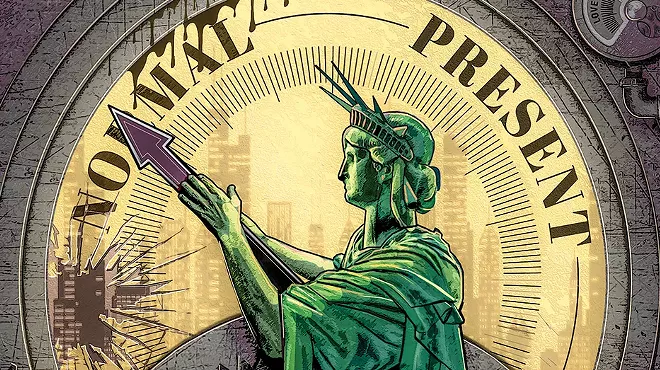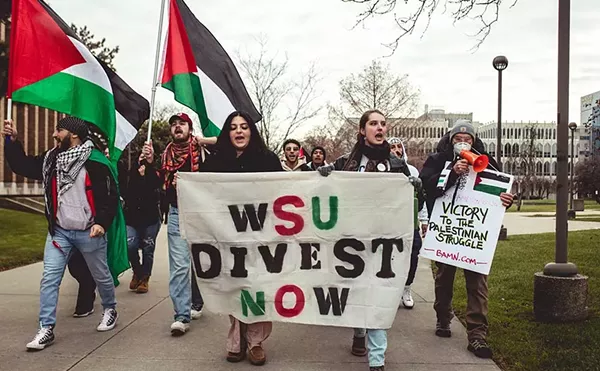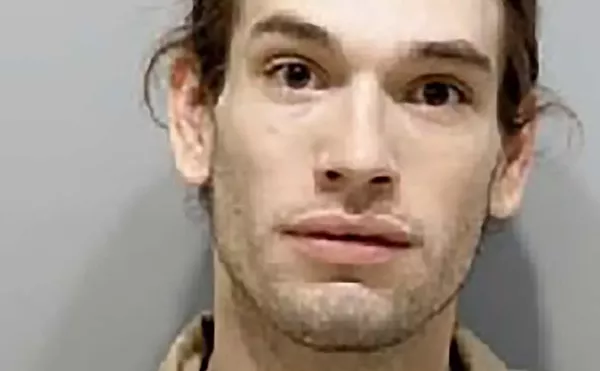
"Project Censored" has been a tough sell since its inception in 1976. Identifying the most important stories of each year on the basis of the exposure that was denied to them by forces beyond the first amendment is a pretty reliable recipe for disillusionment. Nonetheless, the doomy gloom that seeps into my mood when Project Censored is released every autumn is partly my fault. Inevitably, my focus is on the top 25 censored stories and the chapter on Junk Food News, where the same storylines tend to reemerge. The same backstories, too, often feature journalists who wind up dead as a result of their work.
The work is never-ending. There’s always another foe attempting to stand in the way of trustworthy news reporting. But over the past few years, Project Censored is doing more to report on what work is being done to support quality journalism and the fight against fake news, false narratives, and willful manipulation of the public. The result is a budding optimism in dark and depressing times in the wake of the Donald Trump administration.
Project Censored’s executive directors, Mickey Huff and Andy Lee Roth have long argued that “critical media education — rather than censorship, blacklists, privatized fact-checkers, or legislative bans — is the best weapon for fighting the ongoing fake news invasion.”
Project Censored’s annual list of 25 censored stories makes up the book’s lengthy first chapter, and the chapters looking at what happened to previously listed censored stories and examples of news abuse and junk food news, are still one of the best resources one can have for critical media education. However, the chapters reporting on the work of training up new generations of news consumers and journalists equipped with critical media literacy and efforts to transform the news media financing model from one dependent on capitalism to a publicly financed utility is the bright spot in the latest edition of State of the Free Press.
Giving Credit Where Credit is Due
It’s been five months since Project Censored went to press with the 2022 edition of State of the Free Press. So I asked Project Censored’s Mickey Huff and Andy Lee Roth what has happened that is particularly noteworthy since the book went to press.
Their immediate answer was the continued fallout from the attempted Jan. 6 insurrection. Huff and Roth give credit where credit was due to the Washington Post for reporting on what many have called an attempted insurrection and its aftermath over the past several months in the forward of the new book.
“The Washington Post is doing some quite impressive and important investigative work on detailing what happened in the lead up to Jan. 6, which goes all the way back to planning by high-level officials all the way back to the day after the 2020 elections,” Huff said.
He continued that while they know more about what happened in greater depth, nothing has happened that requires a rewriting or rethinking of the book that was published.
Roth dovetailed Huff’s comment by explaining that not everything that corporate media does is wrong or bogus.
“It’s that it needs to be scrutinized carefully given its prevalence, its size, its reach, and influence,” Roth said. “Big papers like the Post have major resources and sometimes they dedicate them to really reporting things in the public interest like in this recent report over the weekend.” (Roth was referencing the Washington Post’s release of “The Attack: Before, During and After,” an investigation of the Jan. 6 Capitol insurrection and its aftermath, a three-part immersive series examining Jan. 6 and its fallout through audio, video, photography, and news reporting).
As much as Roth is willing to give the Washington Post kudos for its reporting, he also quickly reminded me that Amazon founder and multi-billionaire Jeff Bezos still owns the Washington Post.
“This whole year at least the Washington Post has been very biased about not sticking it to billionaires, not taxing billionaires,” Roth said. “So again, these kinds of major news publications often speak out of both sides of a corporate mouth, but I do want to make sure we say they also do report sometimes on the public interest and when they do, they illustrate how significant a free press really is for a society like ours.”
The Pinpoint of Light in the Darkness
Huff said the thing that gives him hope is the involvement of students getting hands-on training in critical media literacy and doing the work with the understanding that when they do good work, it will have a public audience and someone beyond the teacher in their class will read and be affected by what they've done. Huff was speaking specifically about the students who are a part of Project Censored’s campus affiliates program, who do the initial identification and vetting research on the stories that make up each year's top 25 list. He also noted the student involvement as researchers and co-authors in several of the chapters of the book. Roth said that for him, the hope that shines through State of the Free Press comes from those students in the affiliates program and seeing the increased awareness of the kinds of concerns that Project Censored has been raising for the past 45 years.
“And they are not alone. And there is a community of people for whom these issues of media accountability and critical media literacy are out there for them to which to belong if they so choose,” Roth said. “Both individually and collectively, this is one of the things I'm most proud of with regard to the project. It’s how the project brings people together and how under the umbrella of the project. I think we all end up maybe feeling stronger than we would if we were just acting individually.”
Huff agreed, explaining that it’s the students who are guiding the optimism reflected in State of the Free Press.
They see them go through the transformations from people who pay only modest attention to the news, or they model the habits of their families or peers, to empowered students who think for themselves and think independently about media to the degree that they are invited to become the media.
“I think that's the optimistic part,” Huff said.
Circling back to the latest edition of State of the Free Press, Huff explains that the other thing the book does, particularly the top-25 chapter, is it celebrates the work of the “intrepid, independent journalists and the independent news outlets that make their work publicly available.”
“In a kind of glass is half-full sort of way... If we didn't have these Intrepid independent journalists and news outlets, a lot of these stories we would know nothing at all about or we would know only a partial version of those stories and those are situations where ignorance would not be bliss,” Huff explained.
He further explained that part of the hope for the future is that by making people increasingly aware of the kind of so-called alternative news sources that are out there, a better future is possible as we see news that is more diverse in its definitions of what and who is newsworthy.
The Dangers that Remain
But the dangers to freedom of expression, press freedom and our democracy, remain. I asked Huff and Roth to comment on the chapter authored by Robin Anderson, “False Balance in Media Coverage Undermines Democracy: News Abuse in 2020–2021.” Anderson highlights examples of news abuse in the form of a year in review starting with the Jan. 6 insurrection. From one subhead to the next, Anderson recounted the ways the mainstream press missed the story: “Media Caught by Surprise on Jan. 6;” “Media Miss the Story of the Decade” (as it did during the Iran-Contra scandal; “Corporate Media Fail the Public Before and after the 2020 Elections.”)
Anderson would go on to narrate the failures of the mainstream press compared to the alternative press as described in the differences in reporting on police rioting at Black Lives Matter demonstrations across the country. Anderson called out the mainstream press’ adoption of covering violent right-wing counter-demonstrations to BLM protests using the false-balance frame. Arguably, this “both-side-ism” approach to reporting has increasingly come into vogue amongst the mainstream press since President Barack Obama’s first term in office in which there were false equivalencies in discussions of white domestic terrorism and antipolice brutality protests.
I asked Huff and Roth what we should expect if we continue down this path in which the mainstream press continues to distort reality using the false-balance framing of events.
Huff says he thinks the false-balancing of events goes back to a long-standing journalistic commitment to objectivity. He explained that one of the ways that objectivity is specified or enacted is through notions of balance.
Huff went on to explain that there are many media scholars who have argued how journalistic commitment to objectivity in the form of balance creates opportunities for people who manipulate journalism for their own interests.
“Because you can say, ‘Wait, there's another side. Let me have my moment.’ And so, I think that the challenge is how do we deal with objectivity in journalism?”
Huff noted that most people want news that we can trust ― news that has some sense that what we're getting is real and not partisan.
“But the way that journalism as a profession has gone about doing that, at least in the United States, has had this loophole in it ... it's like how we talk about software. There's a back door that can be exploited. Balance has been the back door in the journalistic software,” Huff said.
Huff thinks that one way forward could be to go back to what it means to have freedom of expression.
“In the U.S., we’re a very individualistic culture,” Huff explained. “We tend to think of the right to free speech as my right to say what I think is right. But there is a growing movement of scholars, and activists, and others ― and I would include Project Censored in this ― who are saying, ‘no, we need to think of freedom of expression in terms of the right to hear, and specifically, the right to hear diverse perspectives and viewpoints.’”
Roth offers the analysis that Anderson is saying that, at least in the United States, we are emphasizing too much the right to speak versus the collective right to hear.
“That's how you get platforms for people spouting the most hateful rhetoric and members of the press treating that rhetoric as newsworthy,” Roth said. “That's part of how you get cancel culture.”
Roth notes that Anderson gets very specific in her discussion about how false balancing has distorted establishment news coverage of storylines such as the Black Lives Matter protest movement, the so-called stolen election, or the Jan. 6 insurrection attempt.
“She's very specific and very concrete in the [news abuse] chapter about how establishment news’ reliance on balance has led to distorted reporting on those things,” Roth said.
Roth’s response intrigued me enough to push for further discussion about what it would look like if we lived in a paradigm in which the right of the collective of humanity to hear diverse viewpoints was emphasized instead of an individual’s right to speak. Roth asked Huff to chime in given the number of times he has spoken on the issue, particularly in relation to today’s cancel culture.
Huff said he sides with the perspective of human rights attorney, Dan Kovalik, who is an anti-imperialist author and journalist. He wrote a book called Cancel This Book: The Progressive Case Against Cancel Culture. Huff explained that it isn’t what you think it is until you read it, saying that Kovalik gets into the weeds and details to discuss cancel culture.
“I think part of this balance question that gets really tricky is what Andy was saying, that balance can be wielded as a weapon or as a back door, but we have to remember that canceling is censorship,” Huff said. “So we need to go back and take a look at the definition of censorship.”
Huff noted that the project uses the definition of censorship that goes back to 1776, which is anything that interferes with the free flow of information in a society that purports to have free press systems.
He said we need to be very careful that on the one hand the very powerful and wealthy who control the institutions, the government, the lobbyist and corporations regularly engage in varying degrees or shades of censorship and curation.
“Cancel culture tends to be more overt,” Huff explained. “It tends to be public censorship designed in a way to be punitive. We're punishing and ostracizing for an unpopular position.”
Huff said caution is needed still, because, who gets to decide who needs to be punished and ostracized?
“We need to be very careful from right to left and in between on that weird ideological matrix that we don't somehow slide ourselves into a rationalized position where censorship becomes not just an option, but it becomes an approach,” he said.
Roth noted that there are numerous individuals and groups on the left end of the political spectrum that engage in varying degrees of curation and censorship, and said he knows that that is something for those on the left that is a difficult thing to swallow, and an easier thing to justify.
“My bigger point and Kovalik’s bigger point is that we need to keep sight of the forest for the trees,” Roth said. “And so I'm very cautious about having people or groups or individuals be ‘canceled’ or ‘censored.’”
Roth pointed out that there are already laws against hate speech and they should be used instead of us getting distracted in a cycle of cancellation. He held up the recent backlash against the perceived transphobic comments of Dave Chappelle in his third Netflix special, The Closer. Roth noted that the current discussion is whether Chappelle had punched up or down in his commentary.
Roth argued that it shouldn’t be about Chappelle. Instead, it should be about asking what people are doing and saying.
“How is it being perceived by various groups? Are there channels for these groups to convey back or have open dialogue and be heard in meaningful ways? If the answer to that is no, then we have a problem,” Roth said. “I think that is where we should be focusing. Not just the channels of power, but the conduits of communication.
Roth explained that that is part of what critical media literacy does. Critical media literacy opens channels of communication. It doesn't advocate shutting them down.
“In other words, when I have students in class, and they bring views that maybe some people don't agree with, is it advantageous for me to shut them down, to call them names and ostracize them? Or is it a better idea to hear them out, ask questions, understand where they're getting their information and their ideas, and use it as an opportunity to turn it into something different.”
In this alternative, Huff says there’s the potential for a seed to be planted that will change the way that person thinks and sees the world.
“If we're going to knee-jerk our cancellation of ideas with that, which we disagree, I think we're on a slippery slope in the wrong direction if we want to have an open society,” Huff said.
But he said this with a lot of caveats because he believes there are certain types of communication and certain messages that are harmful to certain groups.
“And we simultaneously need to be very mindful of that,” Huff said. “Because those of us that may one time be in a position of privilege may be at the receiving end of that kind of targeted communication at some other time in our lives and careers. And so it’s speaking of balance in a different sense.”
It's a real tight rope and the gale winds are blowing, Huff said. He said he thinks it's very difficult for us to maintain a true north compass in that kind of environment, but thinks it's worth the effort by trying to call attention to that very dynamic of what it means to live in a society with freedom of the press in the first place and not to the never-ending cycle of the Chappelles versus the Whoevers.
Andy jumped in and offered a point of clarification about the collective right to hear. He explained that the collective right to hear doesn't mean that we as individuals or as a community has to accept as legitimate or ethical everything that’s said.
“I'm prompted to say this by what Mickey is talking about in the context of his classroom, where a popular view comes up and gets aired,” Roth said. The unpopular view is not going to get written off without consideration, but it's also not going to be accepted as valid or legitimate just because someone in the classroom said it. These ideals are all hinged on the idea that we have people who are ready to think and engage.
Roth explained that this goes back to the education in critical media literacy which is preparing students to consider viewpoints that differ from their own, instead of dismissing them out of hand. He notes that that is difficult work in a society with an inequality that is pervasive, structurally based and historically rooted. It is like Huff’s visual of walking a tightrope amidst gale-force winds. Except the tightrope walker is not simply an individual, but rather individuals forming neighborhoods and whole communities, and ultimately society while on this tightrope amidst gale-force winds.
Stay connected with Detroit Metro Times. Subscribe to our newsletters, and follow us on Google News, Apple News, Twitter, Facebook, Instagram, or Reddit.







